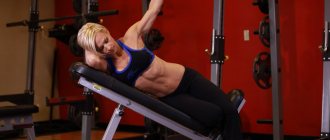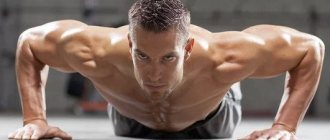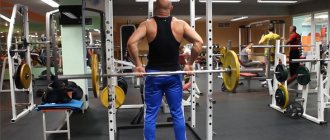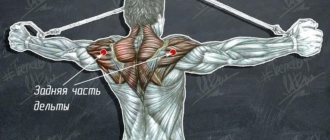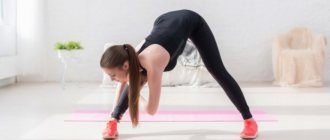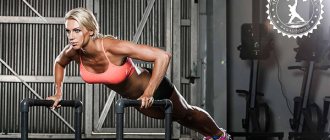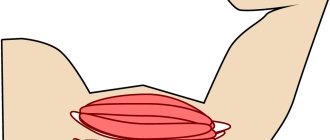Recommendations: how to pump up your rear deltoids
- In order for your shoulders to noticeably increase in volume, you need to work with more weight.
- It is important that the number of repetitions does not exceed 12 times, optimally 8-12.
- Both men and women need to feel a good load; it is the burning sensation in the muscle during the last repetitions that indicates the correct choice of weight.
- The last two repetitions must be performed with all your might - this is a very important condition.
Only if all recommendations are followed, muscle growth is ensured.
Girls do not necessarily need to develop their posterior delta with exercises in the weight training mode. The endurance mode is quite suitable - 15-20 repetitions of 3 sets, while the muscles will have a sporty and feminine appearance.
Also, do not overload , do no more than 1-2 workouts per week. Tired and overtrained muscles will not increase in volume and training will simply lose its meaning. is equally important for muscle growth, especially after training. The formation of new muscle fibers requires proteins, fats and carbohydrates. It is proteins and carbohydrates that are the building materials and energy fuel for muscles. Eat 4-5 times a day, and after training, eat food within 40 minutes, and then you will get beautiful and shaped shoulders.
Useful tips
When working on the shoulder muscles, you must follow the following recommendations:
- Have barbells and dumbbells for training. Their weight depends on physiological capabilities. You should select options to allow you to do 10 or more repetitions. For 1 workout, 5 to 10 sets should be performed. A woman is not recommended to lift more than 5 kg. If the goal is to pump up your shoulders, making them wider and more massive, then you can take heavier weights. If the main goal is to reduce the shoulders and narrow the back, then the weight is minimal. The emphasis should be on increasing the number of approaches.
- Increase study periods little by little. Women have average muscle mass and injuries may occur with sudden exertion.
- Remember about the risk of getting a sprain, so strictly follow the technology even if you are in good physical shape.
- First, the technique must be carefully worked out without dumbbells and barbells, and then move on to movements with minimal weight.
- Don't forget about warming up. It is required before every workout.
- Don't be afraid of muscle pain at first. This is normal: pain indicates that you have received the required load. A warm salt bath with lavender oil will help eliminate it. After the bath, you need to thoroughly rub your muscles.
- To noticeably increase your shoulders, it is better to work with heavy weights.
- The best number of repetitions is 8-12 times. The final 2 repetitions should be performed with all your might.
- You should not overload your body with training.
Rear delt exercises
Wide, massive shoulders are one of the essential components of a beautiful male figure, so during training you should pay attention not only to the biceps and triceps, but also to the deltoid muscles of the shoulder.
Representatives of the fair sex should not forget about them, since it is the rear deltoid that makes it possible to create a harmonious figure and avoid stooping. What exercises for the rear delta allow you to achieve maximum results, and how to perform them correctly? This will be discussed further.
Location and functions of the posterior deltoid
The posterior bundle of the deltoid muscle originates from the lower edge of the spine of the scapula and is attached to the deltoid tuberosity of the humerus.
The posterior delta is involved in horizontal extension of the shoulder. Thus, the posterior bundle is a synergist for bench presses or push-ups, where the teres minor and infraspinatus muscles also take part. The posterior bundle is also involved in hyperextension of the shoulder, where the triceps serves as a synergist.
What is the rear deltoid?
First of all, it is worth emphasizing that the main role in the formation of the shoulder (the trapezius muscle is also added from the back). This deltoid muscle consists of three bundles - clavicular, acromial and spinous.
It is the latter that is the very rear deltoid that worries so many athletes. It is worth emphasizing that this muscle is not too large in size, so it would seem that pumping it up is not difficult.
However, a problem arises here: the fact is that when performing basic exercises, only the front and middle deltas are included in the work, while the back one “relaxes.”
Thus, the athlete does not feel the load on this part of the muscle, forgets about it, and the result remains disastrous - if you look at the shoulders from the side, they do not look too massive and disproportionate compared to pumped up arms.
Special isolating exercises for the rear delta of the shoulder will help solve this problem - primarily deadlifts. This is due to the fact that the function of this muscle is pulling. She is also responsible for horizontal arm movements.
Workout in the gym
Women do not have to devote a separate day to training their deltoid muscles. The movements can be combined with training the muscles of the back and chest.
Exercises for the rear delts can be as follows:
| Exercise | Description |
| Dumbbell Raises |
|
| Seated raises |
|
| Raises behind your back |
|
To inflate the posterior beam, you can use a special device called a “reverse butterfly”.
How to pump up your rear delts
- Since when performing basic training complexes there is practically no load on the posterior deltoid muscle, attention should be paid to the selection of exercises that will make this part of the shoulder work.
- Although this part of the muscle is not very large in size, it recovers quickly enough, so you can train without long pauses: up to three times a week.
- Remember that the middle delta “steals” the load from the back one - they both perform a pulling function. That is why you should carefully select exercises and listen to your own sensations - how much the back of the muscle is involved in the work.
- When performing rear delt exercises with dumbbells, it is advisable not to swing your arms until you are completely exhausted, but to use so-called drop sets, that is, train by reducing the weight, and use a small number of repetitions during each set. In this case, pauses between approaches should be very short (those who have enough strength can work without stopping).
As a rule, exercises for the rear deltas are performed with equipment - a barbell or dumbbells, but beginners can do them “empty-handed”: at the initial stage, the main task is to feel the location of the muscles.
- It is also effective to perform exercises with your arms one at a time - this will ensure that the back side of the deltoid muscle is loaded.
- Don't chase weight: start training with light equipment and only gradually move on to heavier ones.
- Please note that this muscle bundle consists of fibers that contract quite slowly. They are best developed with prolonged aerobic activity, so those who do not know how to pump up the rear deltoid should prepare for long repetitions and several approaches.
- To pump up these naughty muscles, start your workout with exercises for them. This way, you will achieve a harmonious result faster.
- You can perform a complex for the rear deltas both together with exercises for the shoulders and during back training.
- Do not forget about proper nutrition - although the bundle is small in size, it will need a significant amount of protein (in food or in the form of special protein supplements) to recover.
How to pump up your shoulders, or the best exercises for deltoids in bodybuilding
How to build big, wide shoulders - I never asked myself this question because, oddly enough, my shoulders were always ahead of other muscles and almost always grew well, especially the middle deltoids.
From the very beginning of my bodybuilding practice, I did not have much understanding of the methods and techniques of pumping up muscles, especially the muscles of the shoulder girdle. How to pump your shoulders. How to pump up shoulder muscles, how to develop middle deltoids, etc.
- all these questions were so far away for me that I didn’t even try to find out anything, I just shook my shoulders, as well as other parts of my body.
But what allowed me to achieve results in delt training so quickly?! Genetics? No. Today, looking at photographs of childhood and early youth, we can say with confidence that I, a terrible asthenic, rather have narrow shoulders than normal ones.
Advice!
And I don’t even dare to talk about broad shoulders. However, during the first years of heavy intensive training, I was able not only to increase the mass of the deltoids and expand the shoulder muscles, but also to stretch the very bones of the shoulder girdle.
During the period of rapid puberty, I was constantly hanging on the horizontal bars, always spinning somewhere, doing pull-ups, doing push-ups. And immediately in the post-transition period of my age I began to actively swing.
And already on the formed wide skeleton of the shoulders, I was able to build up plump shoulder muscles without any problems. So what exercises for delts did I do?
The best delt exercises
Almost the only shoulder exercise I did was using a barbell attached to the ground with a T-handle. I stood almost vertically with a slight slope and simply squeezed it out with my hands. At first I found it very difficult and could barely complete 15 reps per set.
With this exercise I pumped up, as I now understand, the middle bundles of the deltoid muscles. As a result, after 10-15 days my deltoids became so strong that it was much easier for me to press the barbell.
But I couldn’t add weight to it, so I simply increased the number of repetitions, bringing them to 35. But my shoulders continued to grow no matter what.
How to pump up your shoulders with dumbbells
About six weeks passed like this. The growth of the shoulder muscles did not stop. Two shoulder exercises: T-bar press for 35 reps and dumbbell lateral raises.
Attention!
Due to the circumstances, I stopped training at the stadium and no longer performed the standing barbell press. But, as it turns out, you can also pump up your shoulders at home. I continued to pump my shoulders at home with just dumbbells.
I replaced the standing barbell press with the standing dumbbell press and continued to perform standing lateral raises. But I also added a third exercise - standing bent over dumbbell raises. With this exercise I began to pump up my rear deltoids, which had hardly been trained before.
It must be said that they were weak, but they responded to the load even faster than the middle deltoids, apparently they were just trying to pull themselves up to the lateral bundles of the deltoid muscles.
In the end, I only pumped up my shoulders with dumbbells. Therefore, answering the question “is it possible to pump up your shoulders with dumbbells”, I answer yes, you can! It's definitely possible.
With what weight to pump your shoulders and how often and how much to pump your deltoids?
It is enough to select the working weight so that you can perform 15-20 repetitions in the deltoids exercise and try to increase the number of repetitions in the set at each workout, without being afraid to bring it to 30-40 per approach. The main thing is the pace, the fast, precise movement of the projectile.
The main rule is that you need to pump your shoulders in a more aerobic style than an anaerobic one. The strength load should be stretched in endurance mode, up to 30 clear repetitions per set.
When I tried to move to heavy weights and perform slowly until 12 repetitions, my shoulders stopped growing and, worst of all, the reverse process of degradation began. The deltoids did not have time to recover for the new workout and gradually the weight of the bar had to be reduced. But don’t think that now I continued to pump my shoulders every three days.
Important!
In the gym I was already lifting every 4th or 5th day. So, my shoulders were trained with emphasis no more than once every 9 days. But with light weights and high reps, they also grew well. And, as I already said, by increasing the working weight, I could not support the process of growth of the shoulder muscles.
Therefore, wisely, I returned to the previous scheme for pumping up the deltas.
So, take note.
The best exercises for the rear delts - features and technique
To pump up your rear deltoid muscles, do exercises with dumbbells and a machine. You can also use a barbell, but it is used much less frequently.
Exercise No. 1
One of the main exercises for pumping up the rear deltoid is dumbbell lateral raises. They are performed in a tilted position and do it as follows: lean forward, fix the upper half of the body at an angle of forty to sixty degrees.
You can rest your forehead on a vertical plane or put on a power belt - this will relieve the load on the spine. The back does not have to be flat - it can be slightly rounded, this will make the exercise more effective. Pull your arms with dumbbells back without straightening your elbows or engaging your arm muscles.
It is very important that the elbow does not “sink”, but also does not lift up - the hand should move in the same horizontal plane. At the top point, tense your muscles for a second or two. The dumbbells should not touch each other at the bottom.
It is better to start performing this exercise with each hand in turn, and only after mastering the technique can you make synchronous movements with both hands. Choose light weight dumbbells. It is better to perform such lifts at a slow pace.
Exercise No. 2
The same movement can be done while sitting - with your torso resting on your hips. Try doing it on an incline bench, and choose a small angle of inclination: the smaller it is, the more actively the rear delta is involved in the work.
Exercise #3
Side raises from a low incline. This is a fairly complex exercise, so it should be performed with the proper level of preparation. Lean forward so that your forehead almost touches your knees.
Relax your hands with dumbbells and lower them - they should practically lie on the floor. To perform the lift, first turn your arms so that your palms are facing up, and only then lift your arms out to the sides. Use light weight - even this will provide the rear deltoid with sufficient load.
Exercise #4
Rear delt exercises with a barbell are less popular, but this does not reduce their effectiveness. Here is one of them: in the Smith machine, lean forward and hold the bar in your hands behind your back. Smoothly pull the barbell towards your lower back.
Pay attention to the correct execution of this pull-up: the palms should be at a short distance on the bar (at shoulder width or slightly closer), otherwise the load will be distributed to the trapezius muscle.
Be sure to lean forward and do not work with free weights - the bar may move horizontally, and the load will not reach the rear deltoid. Finally, don't lift the bar above your lower back.
Exercise #5
You can work your rear delts with a block too. To do this, use minimal weight and move your arms back, keeping your elbows parallel to the ground. Please note that the amplitude of movement should be quite short. But the grip is not of fundamental importance.
Basic exercises
Before you start learning the basics of rear delts, there are a few things you need to understand. In this case, the “base” is less effective than auxiliary exercises (isolating).
This is because this muscle group is small and during basic exercises it is only partially loaded. And since the weak growth of the rear deltas is primarily due to the small load on them, it is the auxiliary exercises that will save the situation. Well, now, actually, a list of these same exercises.
BENT-UP BAR PULL.
Place your feet shoulder-width apart with your knees bent. Bend forward, take the equipment in your hands with an overhand grip. Make sure your elbows don't bend. Bend your torso 30 degrees. Keep your muscles tense. Hold the barbell at knee level. Pull the barbell toward your upper abs, moving your elbows back as high as possible. Try to distribute the load on your back and shoulders, excluding your arms.
Scientists from Norway have proven that barbell exercises are most effective in a standing position.
DUMBBELL ROW ON THE INCLINE.
Can be performed standing or sitting. The technique is the same, only in a sitting position it is necessary to use less working weight. Bend forward at the pelvis, knees bent, lower back arched. The dumbbells must be lifted with the widest possible range, with your elbows slightly bent. You cannot help yourself by springing your legs, otherwise there will be no effect.
LEE HAINEY'S CRAFTS.
This is a barbell (dumbbell) row behind your back. This type of exercise is called the Lee Haney deadlift, in honor of its inventor. Initially, it was performed only using a barbell, but due to the complexity of execution, many people replace it with dumbbells. When working with a barbell, it is better to use a Smith machine.
To do this, you need to approach it with your back, grasp the neck of the instrument approximately shoulder-width apart. Raise the barbell as high as possible, being careful not to bend your elbows. As you exhale, slowly lower it into place.
When performing dumbbell rows for the rear delts, the technique is as follows:
- Place your feet shoulder-width apart. Lean forward slightly. Keep your back straight.
- Inhaling, raise your arms up without bending them. Exhale and lower.
- You can do this with your hands alternately, so you will have better control over the load.
PULL-UPS.
Since the rear delts perform a pulling function, when you pull yourself up, they are actively involved in the work. I just love pull-ups. Last time I pulled it out 30 times. How long do you do pull-ups? Don't give up on this matter. Such a simple exercise can seriously work out the muscles of the arms, back, and the same rear deltoids. Also use close-grip pull-ups.
Rear deltoid exercises - video
To provide this whimsical muscle bundle with a load, you do not need to perform a set of a dozen exercises. It’s enough to start training with a couple of effective movements (don’t forget about the maximum number of repetitions), and soon your shoulders will become beautiful and sculpted.
You can find out what these exercises are and how to do them correctly from the following video. The trainer will not only tell you how to perform the movements, but will also show you. The main mistakes that beginners often make are also listed, and recommendations for working this muscle are given.
Now you know how to pump up the rear delts and provide beautiful shoulder relief. You can exercise several times a week, but don’t forget about rest. When practicing exercises, pay special attention to technique - if you do them incorrectly, the load will be distributed between the triceps, anterior and middle deltoids.
Recommendations for pumping deltas
There is no universal exercise for the deltoid muscles. Basic exercises involve several bundles, but individual zones are still a priority. Therefore, the training program should include a variety of movements for all three beams.
It is extremely rare that this muscle group develops evenly. As a rule, some bundles lag behind - most often these are the back and middle ones, since they are either forgotten about, or the exercises are performed incorrectly, or they do not do enough work, concentrating on the presses alone. Over time, you can focus on these particular beams, starting your shoulder day not with a bench press, but with swings on the rear and middle deltoids
But at the initial stage it is necessary to lean on the base, while not forgetting to pay attention to each beam. For beginners, two or three movements will be enough.
Experienced athletes use 2-4 basic and 2-4 isolation exercises.
The recommended number of approaches per movement is 3-5, the number of repetitions is 8-15. It is recommended to train your shoulders once a week. Only with specialization among experienced athletes can deltas be divided into bundles over two to three days.
Pay special attention to warming up. Shoulders are a complex complex that can be easily damaged
It makes sense to include shoulder movements in the program after training the large muscle groups of the body. This will prepare the deltoids for stress and reduce the risk of injury.
Pumping up the rear deltoid
Many people who go to gyms neglect pumping up the rear deltoid. Like, why bother with it, it’s invisible. Yes, no doubt, the basis of a bodybuilder’s appearance is the abs, arms (biceps, triceps), and chest. And after them they pay attention to the back and legs.
But even if you are not going to compete, you still need to pay attention to this muscle. After all, without a developed rear delta, it is impossible to achieve a spherical appearance of the shoulders. Let's look at how to pump up the rear deltoid.
Functions and anatomy of the deltoid muscle
The usual division of the deltoid muscle mass into posterior, anterior and middle (sometimes called external) is very arbitrary. More precisely, these are different bundles of muscle fibers of one muscle. These beams and their features will be discussed. For simplicity, from now on they will simply be referred to as the posterior, anterior and middle deltas.
This muscle works during various arm lifts. Raising to the sides works the middle deltoid, and raising the arm in front of you works the front part. The back part lifts the arm in a horizontal plane. The deltoid muscle also contributes to the barbell press (as an auxiliary muscle) and is involved in shoulder rotation.
In 2002, an extremely interesting study was carried out. Scientists compared the size of the deltoid muscle in untrained people and in bodybuilding athletes. According to published data, the anterior delta is five times larger in a bodybuilder compared to an average person. The middle part of the delta is three times larger, and the rear is only ten to fifteen percent.
Upon careful examination of the data, a bias in the development of various muscle bundles becomes noticeable. The reason can be found in the standard training program. After all, the main exercise is always the vertical press. Everything else is secondary, just for isolation.
At the same time, athletes believe that in this way they pump all parts of the deltoid muscle. It is believed that the standard chest press pumps up the anterior bundle. When pressing dumbbells, the middle fibers are worked out. If you perform a barbell press from behind your head, then not only the middle, but also the back part of the delta is pumped.
Unfortunately this is not entirely true. With all of these exercises, the front part of the deltoid muscle is worked first. And the rest work only as auxiliaries. The same can be said about such a popular exercise as the “Arnold press.” That's why there is such a skew in development.
But you can fight this. To do this, it is enough to dilute the presses with exercises with dumbbells. And first of all, raise your arms from the sides.
What to take as a basis
Before giving advice on choosing exercises to load the middle delta, you should clarify the fact that not all lateral arm raises are useful specifically for this muscle bundle. It can only be pumped effectively using horizontal lifts. That is, when the athlete’s torso is at a large angle.
The exercise should be considered ideal if the athlete bends over until his torso is parallel to the floor. In order to reduce the load on the lower back, it is necessary to use a special belt. And it will be even more reliable to perform it with your head resting on any convenient support, which can be, for example, an inclined bench.
Another popular, and also very convenient and effective way to perform this exercise is seated bent over arm raises. To do this, you need to sit on a bench, lie with your stomach on your knees and do lifts from the sides.
Unfortunately, the last version of this exercise is not suitable for everyone. Problems with performance may arise due to a large belly. Also, not everyone’s spine is flexible enough to lie completely on their knees.
You can also simply lie on an inclined bench, and you can lie either face down or on your back. Moreover, the closer to the horizontal position, the more the posterior muscle bundle is pumped. At an inclination angle of more than forty-five degrees, the middle delta is pumped up more, but the back of the muscle also works.
Low bow
The hardest way to perform lateral raises is to bend forward to the maximum. Ideally, reaching your face to your knees. This option is not suitable for everyone, because not everyone is able to turn out this way. When performing it, it is better not to use too much weight, and with small dumbbells this exercise will not seem easy to you.
Also, many athletes and coaches recommend a more complex version of raising your arms. To do this, you should rest your head against the back of the inclined bench, while bending below the horizontal. With this design, efficiency increases many times over.
In modern bodybuilding there are practically no places left where exercise machines are not used. There is also a specialized unit for pumping the delta. This is a simulator designed for the rear delta with a rather beautiful name - reverse butterfly. It is likely that this is not the only option, but you won’t find others in the halls.
With the help of this projectile you can easily pump up the posterior muscle bundle. There are two ways to use this simulator. With one, the palms look inward, with the other, outward. The right one for you will be the one after which you will feel the delta more strongly.
Unfortunately, this simulator is almost a museum rarity. But it can easily be replaced with a regular crossover. In this case, you can work with both the lower and upper blocks. The only thing that needs to be noted is that when working with the lower block, you get the same bent over arm raises. Just without dumbbells.
Before performing exercises on a high block, it is advisable to prepare the apparatus for work. Preparation consists of removing the handle from it. In principle, if you feel more comfortable working with them, then you can leave them on.
After this, grab the stops or handles with your hands and begin to cross your arms. During these movements, you need to lean back as much as possible. If it is possible to use a paired block, then you can work with neighboring crossovers. This will increase the positive effect. Ideally, to achieve a greater load on the muscles being worked, it is better to work not while standing, but on a bench.
Alternative view
All of the above methods of training the deltoid muscle are common and can be found in almost any gym. But there is another, very unusual view on delta training. Some fairly respected athletes have made themselves rounded, even shoulders without bending or using exercise machines.
Alexey Shabun can easily be considered such athletes. This method of training brought him quite good results. To pump up the rear deltoid, he uses a Smith machine. To do this, he stands with his back to him and performs lifts of the barbell behind his back to the height of his lower back. Only the posterior delta fibers work this way.
Without a Smith machine, doing this exercise is useless. After all, for proper execution, the bar should not move horizontally. With such a displacement, the trapezoids will take on the load. And with free weights it is almost impossible to avoid such a turn.
The grip width and amplitude of execution are also important. Do not grab the bar with a grip wider than your shoulders. It is also important not to lift the barbell above your lower back. If the grip is too wide and the lift is high, the load will be redistributed to the trapezius, which in this case is undesirable.
Reps and Weights
There is a widespread belief that it is necessary to work with heavy weights when building up the delta. Although this approach is fundamentally wrong. After all, the entire deltoid muscle, any of its bundles, consists of slow-twitch fibers. It follows from this that this muscle requires work “for wear and tear”.
It follows from this that the most effective way to train the rear deltoid will be somewhere between fifteen and twenty repetitions. Of course, this does not mean that you should completely throw heavy weights. Sometimes you can work with weights that you can’t handle more than five times, but this shouldn’t become the norm. Such training can be used occasionally and only to diversify the process.
It is also necessary to perform as many approaches as possible. Deltas simply need to be starved out. The number of sets should not be less than ten, but preferably there should be 12-15. Otherwise, all your efforts will not be crowned with success.
For high-quality work on the rear and middle deltas, it is better to set aside a separate day. On this day you will only perform exercises for these two bundles. It’s better to take bent-over dumbbell raises as a basis. You can also do a rear exercise on a Smith machine. After completing this basics, you can finish off the muscle using a block. Thus, it is better to train once a week.
If you work like this, then after a few months of hard work on your body, you will have rounded shoulders. The main thing to remember is that the results of delta training are not immediately noticeable.
Many people who go to gyms neglect pumping up the rear deltoid. Like, why bother with it, it’s invisible. Yes, no doubt, the basis of a bodybuilder’s appearance is the abs, arms (biceps, triceps), and chest. And after them they pay attention to the back and legs. But even if you are not going to compete, you still need to.
Hello friends! Now we have reached the most problematic part of our shoulders - the dorsal deltoids. Now we’ll figure out what to load it with and how to train it.
The rear deltoid muscles, according to statistics, are the most difficult to develop. They least in basic exercises, such as presses, and therefore their size is often inferior to the size of their two “neighbors”.
It is this part of the shoulder that gives us visual volume when viewed from the side , and also makes the shoulder as a whole more round in shape. So pumping up the rear delts is a must for everyone. Let's start looking at the exercises, there are not many of them, but they very accurately create the conditions for the growth of the dorsal delta.
DUMBBELL FLIES INCLINED
Here it is, in my opinion, the most effective exercise for the rear heads of the deltas. To perform this exercise is quite difficult and requires a lot of effort. There are options with supports, but I will describe the heaviest and highest quality without them. The main rules of execution are the choice of a small adequate weight and the absence of jerking movements and the inclusion of inertial components.
Performance
- We stand with dumbbells in our hands, palms facing each other, feet shoulder-width apart, tilt the body as parallel to the floor as possible, but without falling forward. We bend our back in the lower back, do not slouch in any way, the head looks forward or down (I recommend forward, to fix the cervical vertebrae).
- We bend our elbows 15-20 degrees and fix them – we don’t change the angle while performing. Inhale and hold your breath to stabilize the position.
- We raise our arms up, not reaching parallel with the floor. Make sure your elbows are always higher than your wrists.
At the top point, exhale and forcefully bring the movement a little higher, then slowly lower the weights down. We perform without jerking, without cheating, clearly controlling the entire exercise.
Options: sitting, with head support (for example, the top of the back of a bench), with wrist rotation, using a crossover while sitting.
LYING DUMBELL FLIES
It would seem similar to the previous exercise, but there is one significant difference. And it consists in the fact that we achieve greater insulation by removing stress from the body and legs. On the one hand, this is good, because we can concentrate more on the execution technique and not hold the string of the back bend. On the other hand, I am always an advocate of both free weights and natural exercise poses. This is because by using different blocks of certain parts of the body, we exclude stabilizing muscles and synergistic muscles from the work. However, this option is more preferable for drawing the rear delt, especially when drying.
Performance
- We lie down on our stomachs on a horizontal or positively inclined bench. Feet stand with toes on the floor and bent at the knees, the angle is greater than right. We'll set it up the way it's most convenient for you.
- The head looks forward (or down). There are dumbbells in your hands, palms facing each other, elbows, as in the previous version, slightly bent .
- We take a breath and raise our hands. At the top point, exhale with effort, then return to the starting position.
Options: with rotating brushes.
PECK-DECK
This is the name of the type of simulator on which we will perform the exercise for the posterior bundle of the deltoid muscle of the shoulder. This option for training the rear delta heads is good because, in my opinion, it is the easiest and most convenient to perform. The legs and lower back do not receive stress, the position is comfortable and the movements are fixed along one axis, which reduces the likelihood of incorrect execution. An additional advantage of using this exercise is partial training of the rotator cuff muscles, which are responsible for the performance of the joints and the wear resistance of our shoulder joints.
Performance
- We sit down in the simulator, adjust the width of the handles so that the hands, when held, are shoulder-width apart.
- The grip is neutral - that is, the palms are facing each other (or straight, depending on the design), the elbows are bent.
- We take a breath and spread our arms in different directions. At the peak of the load, we exhale with effort, slightly prolonging the movement. Then inhale smoothly and return to the starting position.
We do everything, as in all exercises for deltas, smoothly and meaningfully .
Options: the design of the simulator allows you to perform it with almost straight arms.
BREAKING HANDS IN A CROSSOVER
Another wiring for the rear beams. This time using a crossover. In terms of difficulty of execution and effectiveness, as well as the degree of isolation, I would characterize this exercise as average, between the peck-deck option and the bent-over dumbbell fly. In this case, we will perform the exercise while standing , but without fixing parts of the body. That is, this is a simpler option in terms of maintaining balance and eliminating inertia and jerking. At the same time, it involves many muscles.
Performance
- We stand straight, in line, with our heads looking forward.
- We hold the handles of the crossover so that the cables are crosswise, and the arms are bent at the elbows.
- After inhaling and holding your breath, we straighten (but not completely) and spread our arms. At the end point – exhale and complete the movement with effort. Then return to the starting position.
variations in this exercise.
This concludes my review of a number of exercises for the back of the deltoids. Try all the options and, at the initial stage, choose the most comfortable ones. And only then you will be able to perform complex, but also more effective exercises.
Try to include at least one exercise for these muscles in your training program early
Phil
Posterior deltoid training program
Productive and popular exercises for the rear delta of the shoulder are pull-ups, weighted bendings, vertical pull-downs, and T-bars. A standard set of exercises affects the front and middle bundles of muscles; accordingly, the back part lags behind in development over time. Also, the posterior heads of the deltoid muscles may not grow for other reasons:
- during training it is difficult to feel the muscles of the posterior bundles
- during training, the side beam is able to take the load from the back one and, therefore, pump up much faster
How to pump up your rear delts using pulley rows?
Pull the handle of the block towards you smoothly, avoiding sudden movements, and your elbows should not deviate. Start your first rear delt pull-down exercises with 3 sets of 12 repetitions, gradually increasing the load to 5-6 sets of 12-15 reps.
Rear delt exercises with dumbbells
Before you start doing bent-over exercises, it is important to choose the optimal weight of dumbbells for yourself. That is, choose the weight of the projectile so that after 12 repetitions the muscles are not overloaded, but it should not be too easy either. You should exercise at a slow pace, this will allow you to pump up the back of the deltoid muscles.
How to pump up the rear delts using reverse wiring?
The workout is similar to the previous one, but there are some differences. The exercise is performed lying on a bench, with your arms outstretched (palms facing down). When extending your arms with a weight to the sides, your hands should be rotated 90 degrees. 3 approaches of 12 times are enough.
Dumbbell flyes
I consider standing dumbbell flyes to be the main exercise for deltoids . Yes, for the whole body this is an isolated exercise, but for the middle head of the deltas this is a basic exercise. The lateral head moves the arm away from the body, so why not train this function by simply holding dumbbells? Simple and most effective.
In order to perform technically correct dumbbell flyes while standing, you need to remember that the elbow joint at the top point of the movement should always remain above the hand. Movement occurs only in the shoulder joint, the arms move only in the plane of the body to the sides, the movement is determined by the humerus, not the hands. You must try to pull the projectile up as if with your elbows. You should not raise the humerus above the level of the deltas, this is fraught with injuries and the involvement of the trapezius muscles.
As a rule, in this exercise they do not use large weights, but try to take moderate weights for 10-12 or more repetitions. All movements are smooth, the arms should not be absolutely straight, they are allowed to bend at the elbows, but not to a right angle. To engage the middle deltoid as much as possible, it is recommended to lean forward slightly.
How to pump up your rear delts at home
If you do not properly train the muscles of the rear deltas, then the shoulder girdle will look underdeveloped. At home, it is difficult to achieve the desired results, especially when it comes to creating a powerful, proportional body, since it requires constant supervision from an experienced trainer.
To perform exercises at home, you will need collapsible dumbbells, thanks to which you can freely install any weight. In order for training at home to be effective, it is necessary to observe the regularity and intensity of exercise, sleep and rest patterns, and also eat properly.
As the main exercises for the rear deltas at home, it is recommended to choose the “Arnold Press” - 2 sets of 7 times; raising arms in a standing position - 2 sets of 10 times; Bent-over raises – 2 sets of 8 reps. The total duration of training should be at least 5 weeks.
Principles of rear delt training at home
- High intensity - perform 1 basic exercise and 2-3 auxiliary exercises. At the end of each exercise, stretch the loaded muscles.
- A competent split - you should pump the rear deltoids and pectoral muscles on different days, it is better if the interval between them is at least 2 days. This will allow you to give 100%.
How to quickly pump up your rear delts?
It is known that basic exercises for the rear deltoids are better for building muscle mass, but this applies more to large muscle groups. Basic exercises include deadlifts - barbells, dumbbells, T-bars, vertical blocks, etc. Isolation exercises are more effective because they allow you to pump a specific muscle group. The following isolation exercises are suitable for developing the rear delts:
- dumbbell swings in an inclined position
- wiring in the simulator
On a note! The result will be noticeable when you learn to feel the burning and contraction of muscles.
Exercise “rear delt swings with dumbbells”
Simple tips that will help you achieve positive results in a short period of time.
You should start with a light weight - this will allow you to monitor the amplitude of movement of the sports equipment at each point.
- Do not bend more than 60 degrees, otherwise the load will be transferred to your back.
- Learn to “turn off” your forearms - this will allow you to maximally load your rear deltoids.
- Try using drop sets - for example, 1 approach, weight of the projectile 15 kg - 10 repetitions, 2 approach, weight of the projectile 10 kg - 7 times and 3 approach, weight of the projectile 5 kg - as many times as possible. There should be no rest between approaches. It is enough to carry out 4 drop sets at a time.
- When lifting the dumbbells up, hover in this position for at least 2-3 seconds.
- If you are not yet able to swing the rear delt with dumbbells, then you can perform regular swings with your arms in an inclined position - this will teach you to feel which bunch of deltas is working at the moment.
- In order to understand how the back of the muscles works, start exercising with one hand. This way you can concentrate on a specific beam and build it up more actively.
The role of exercise machines for pumping the rear deltas
To pump up the rear bundles of deltoid muscles, there is a special simulator - “reverse butterfly”. To achieve visible results, it is necessary to correctly perform the rear deltoid exercise in the simulator, especially for the arms. An alternative option is a traditional crossover. The effect is guaranteed if you exercise on the upper block. It is enough to remove the handles from the block and grab the stops themselves. The further you can lean back, the better for the deltas.
Isolation exercises
ON THE PECK-DECK TRAINER (butterfly).
The butterfly exercise machine has a very effective effect on the rear delta. Let's look at a training option:
- Adjust the position of the handles and the machine chair. Hands should be shoulder-width apart, parallel to the floor. Press your chest against the back of the Peck-Deck and place your hands on the handles.
- Inhale, and holding your breath and bringing the muscles of the rear delta into tension, spread your arms as far as possible. Hold for a second, exhale.
- Return to the starting position.
TRAINING IN A CROSSOVER.
Install a crossover, it is better to start with a small weight. Stand in the middle, put one leg slightly forward, bend the other slightly. Take the left handle with your right hand, and the right handle with your left. Stretch your arms back, keeping them at eye level. Close them in front of you.
ABDUTION OF THE ARM IN THE TILT.
This exercise is similar to the dumbbell row. Place the machine on the lower block. Bend forward at the pelvis, knees bent, lower back arched. Pull the cable with your opposite hand as wide a range as possible, with your elbows slightly bent
INCLINED DUMBBELL FLIES.
A very difficult exercise indeed. It has always been difficult for me to do, although I love doing it. The only difficulty, again, is that it’s difficult for you to do it well. Learning to turn off your arms and back muscles so that only the deltoids work, at first it was difficult to keep your back straight.
But to master it, you need to adhere to these golden rules. If you apply this, then everything will be OK:
- Always start by mastering perfect technique. This is critical here. Even to the point of asking someone in the room to give their opinion from the outside on how you perform it. Don't hunch over, don't slouch, etc.
- Always use small weights first.
- At the top point, hold for a couple of seconds. It's difficult and you'll understand why when you try it. But this will give a good muscle contraction.
- Try to perform swings not with 2 hands at once, but first with one hand and then with the other hand. This will help you concentrate better.
- Don't try to bend your torso parallel to the floor (although I often do this).
Pumping the rear delts with professionals
The best exercises for the rear delts from Denis Semenikhin
You can pump up gorgeous deltoids in different ways, but sometimes not everyone has sports equipment (dumbbells, barbells, etc.) at hand.
In the video, Denis clearly demonstrates how to train the deltoid muscles without sports equipment. The exercise “barbell press” (in the absence of sports equipment, you can use a stone weighing no more than 40 kg) is performed lying on a bench for 2 sets of 5-6 times. When performing the exercise, an important point is to exhale while lifting. A close-grip push-up from a bench is suitable as a finishing exercise. After a 15 second break, we switch to overhead presses in a standing position. We finish the workout with push-ups from the floor, head down.
Advice: train intensely, combine exercises in groups, train adjacent muscle groups so that the divisions between them become clearer.
Exercises for the rear deltas from Yuri Spasokukotsky
Exercise: Smith machine rear delt row. A bench is necessary in order to remove the load from the spine. You can also use a power belt to avoid injury. When performing deadlifts, you do not need to retract your shoulder blades because the rear deltoids lose load. For starters, 3 sets of 15 repetitions will be enough, and for experienced ones - 15 warm-up times and 3 sets of 6-8 repetitions. You should take a short break between approaches, otherwise you can seriously tear your muscles.
Tip: It is not recommended to work out one muscle group more than once a week. But you should train efficiently and intensively.
A slightly rounded back when performing deadlifts, as well as a head lowered all the way down, gives the posterior muscle bundles a colossal load. The lower the inclination of the bench, the higher the load on the deltoids.
Training the rear deltoid muscles - conclusions and recommendations
Above we looked at what the rear delts are and how they can be effectively pumped up with exercise. For beginners, experienced athletes recommend going to the gym first. Once you master all the intricacies of training, you can safely alternate training in the gym and at home. To increase the muscle mass of the rear delts, it is not necessary to train with heavy weights. The intensity of the movements is important.
- learn to feel the tension of the pumped muscle group
- choose gentler exercises for the first time
- keep your technique under control
- When bending with an apparatus, avoid “deep” bends
- do your workout smoothly
- do not forget about the warm-up part before training
- the rear delts are able to recover quickly, so they can be pumped 2-3 times a week.
Forming into a complex
To pump up a bunch of delta muscles you will have to try - this is a fact, but it all depends on the athlete’s experience and desire to achieve results. Newcomers have more than enough initiative, but this does not always allow them to achieve the desired result.
Some tips for creating a training schedule:
If you started training not so long ago and have no experience in sports, then you should not form a complex of 5 or more exercises. 2-3 will be enough, this will allow you to put the delta in order, it will “swing” gradually
It is better to alternate exercises with barbells and dumbbells. If you have more than enough experience in sports and have paid attention to this muscle group for a long time, then feel free to form a complex, but do not train daily, it is enough to work this muscle group 2-3 times a week. Avoid loads, increase them gradually, increasing the duration of the workout.
It would be a good idea to create a schedule coordinating the workload:
| 1 day: | Let's start with working the legs. |
| Day 2: | We load the delta and pectoral muscles. |
| Day 3: | Let the body rest and recuperate. |
| Day 4: | We work the back and rear deltas. |
| Day 5: | work your triceps and biceps, and then proceed to the barbell press. |
